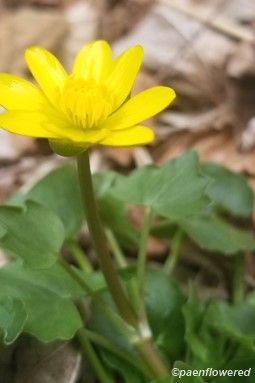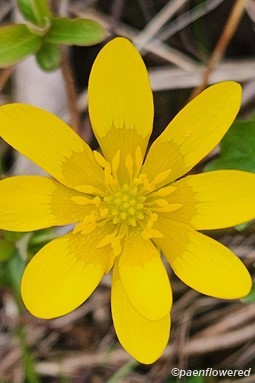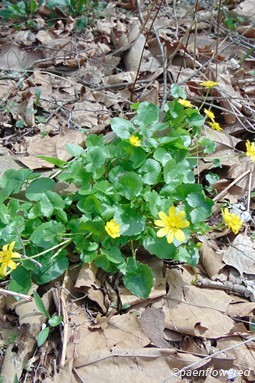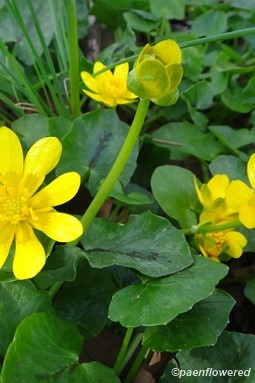Ficaria verna
An invasive alien buttercup
Ficaria verna lesser celandine
Add to MyPlants View Locations
This alien perennial species is a member of the buttercup family, one that does have other species that are native to North America. It was brought as an ornamental plant from Eurasia or North Africa. The attractive yellow flowers have 7-12 glossy petals. The shiny, dark green leaves are long-stalked and heart-shaped. The edges are smooth or lightly scalloped. They tend to cluster at the base of the plant. There is only one flower per stalk. The fruit is a cluster of hairy seed like structures. It can also reproduce by means of bulblets that grow in the leaf axils and easily drop off and are spread by rain to sprout into new plants. The roots produce tubers up to one inch in diameter.
The lesser celandine also has the common name of pilewort because the roots contain chemicals that are effective in treating piles (hemorrhoids). It is also called the fig buttercup.
The plants grow 2-11 inches tall and are found in damp shady locations, though it can tolerate a wide range of growing conditions. It tends to grow in disturbed areas like lawns, roadsides and edges of streams. It is found mostly in the North Eastern United States and Eastern Canada and the northern part of the Mid-West. It has been implicated in the poisoning of livestock that might graze on it. Juices from the plant can cause skin irritation and rash in humans.
In places it can be invasive and crowd out native species. In one area of Ohio it escaped from two gardens and eventually covered 50% of the ground in a nearby park in a thick mat. Local animals and fungi have not yet adapted to eat or infect the lesser celandine.
One variety of lesser celadine has the normal paired chromosomes (diploid), while another has four sets (tetrapoloid). The latter variety seems to grow better in shady areas, and thus is a danger to early spring woodland native plants. Some cultivars, with double flowers do not produce seeds and are not as great a danger as an escapee. Nevertheless this species is not a good overall choice for a garden plant.
The blooming period is March to early June. After that it dies back and becomes dormant. Another alien species is the celandine (Chelidonium majus), but this species has the leaves attached directly to the stems. It is otherwise similar in appearance to the lesser celandine, but a member of the poppy family. The marsh marigold (Caltha palustris), a native species, is also in the buttercup family and grows in damp places. It also has heart-shaped leaves, but both the plant and the flowers are much larger than either celandine. The celandine poppy or wood-poppy (Stylophorum diphyllum) is also in the poppy family, but appears similar to the celandine and lesser celandine. It, however, has deeply lobed leaves.
Habitat & Range
Grows in low, open woods, floodplains, meadows and waste places.
Found throughout the sate, with denser populations in the southeast.
| EMP: | FAC |
|---|---|
| NCNE: | FACW |
Phenology
Flowers March to May.
Characteristics
Height 2 to 11 inches
Similar Species
is not invasive and weedy like F. verna
has 5 to 9 petal-like sepals while F. verna has 3 sepals and up to 12 petals
plant is larger than that of F. verna
has a cluster of flowers per base stem, F. verna has single flower per stem
fruit is a follicle while F. verna's fruit is an achene
Ficaria verna lesser celandine
Synonyms: Ranunculus ficariaAdd to MyPlants View Locations






Comments
Have you spotted this plant in your area? We'd love to hear about your experience! Share your comments or questions about the plant below. Comments are moderated before posting.